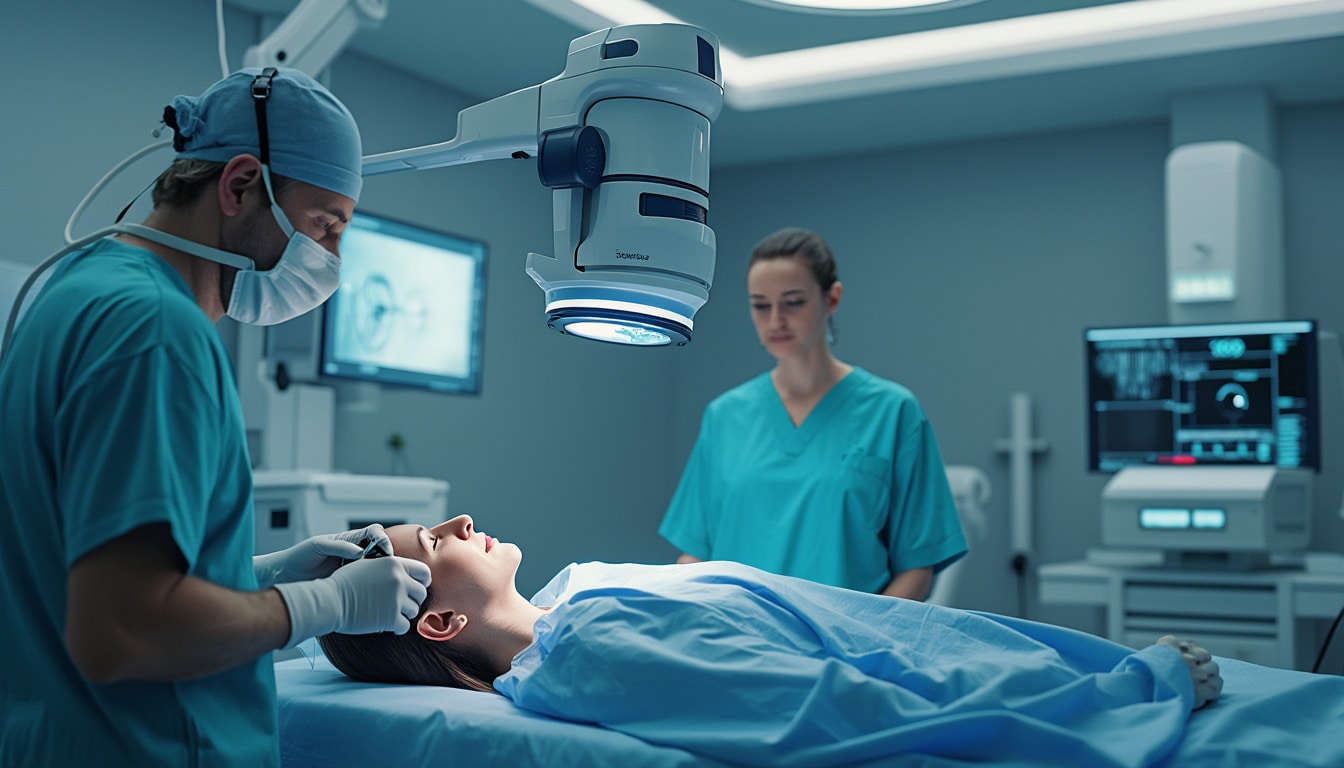« `html
Oops, looks like we’ve hit a snag!Our team is on it and racing against timeto get everything back up and running.
In the meantime, we appreciate your patience and understanding. We’re diligently working to restore the service as quickly as possible. If you’re curious, here’s the mysterious error code: 0.847f3a17.1746085359.21293d1f. Stay tuned as we navigate through this hiccup and ensure everything sails smoothly again.
« `

In the heart of Nantes, a city already renowned for its vibrant culture and technological advancements, a new chapter in presbyopia surgery is being written. This groundbreaking innovation promises to revolutionize the way we address age-related vision impairment, offering hope to millions worldwide. Let’s dive into the fascinating developments that have put Nantes on the map as a hub for medical innovation.
Table of contents
Togglewhat makes the nantes innovation stand out in presbyopia surgery?
Nantes has long been a center for research and development, but this latest advancement in presbyopia surgery truly sets it apart. Unlike traditional methods that often involve invasive procedures and lengthy recovery times, the Nantes team has pioneered a minimally invasive technique that enhances the eye’s natural ability to focus. This approach not only reduces the risk of complications but also significantly shortens the healing process, allowing patients to regain their vision more swiftly and comfortably.
The secret sauce behind this innovation lies in the integration of cutting-edge technology with a deep understanding of ocular physiology. By utilizing advanced laser systems and precision engineering, the surgeons in Nantes can tailor the procedure to each individual’s unique eye structure. This personalized approach ensures optimal outcomes, making the surgery more effective and accessible to a broader population.
how does the new technique improve patient outcomes?
The new technique developed in Nantes offers several key improvements over existing presbyopia surgery methods. First and foremost, the procedure is less invasive, meaning patients experience less pain and discomfort both during and after the surgery. This is achieved through the use of ultra-precise lasers that make incisions with minimal disruption to surrounding tissues.
Moreover, the recovery time is drastically reduced. Patients can typically resume their daily activities within a few days, compared to weeks or even months required by traditional surgeries. This swift recovery is a game-changer, especially for those with active lifestyles or professional commitments that make extended downtime impractical.
Another significant improvement is the enhanced accuracy of the surgery. The Nantes team employs sophisticated imaging technologies that provide real-time feedback, allowing surgeons to make adjustments on the fly. This level of precision ensures that the corrective measures are perfectly aligned with the patient’s vision needs, resulting in clearer and more stable vision post-surgery.
what technology underpins this surgical breakthrough?
At the core of Nantes’ presbyopia surgery innovation is a suite of state-of-the-art technologies that work in harmony to deliver exceptional results. One of the standout features is the use of femtosecond lasers, which emit ultra-short pulses of light that can precisely cut and sculpt the corneal tissue without generating heat that could damage surrounding areas.
Additionally, the procedure incorporates wavefront-guided technology. This allows for a detailed mapping of the eye’s surface, identifying even the smallest irregularities. By addressing these fine imperfections, the surgery can correct not only the primary focus issues associated with presbyopia but also enhance overall visual quality, reducing issues like glare and halos that some patients experience with other techniques.
Furthermore, artificial intelligence plays a pivotal role in planning and executing the surgery. AI algorithms analyze vast amounts of data from each patient’s eye scans to determine the optimal treatment parameters. This ensures that every step of the procedure is tailored to the individual, maximizing the effectiveness and safety of the surgery.
who are the experts behind the Nantes breakthrough?
The innovative presbyopia surgery emerging from Nantes is the brainchild of a collaborative team of ophthalmologists, biomedical engineers, and technologists. Leading this effort is Dr. Marie Dupont, a renowned ophthalmologist with over two decades of experience in eye surgery. Her expertise and dedication to improving patient care have been instrumental in driving this project forward.
Supporting Dr. Dupont is a team of talented biomedical engineers who have developed the specialized laser systems and imaging technologies essential for the procedure. Their combined knowledge of optics, materials science, and software engineering has enabled the creation of tools that are both highly effective and user-friendly for surgical teams.
In addition to the core team, local research institutions and medical centers in Nantes have provided invaluable support through rigorous testing and clinical trials. This collaborative environment fosters continuous innovation and ensures that the surgical techniques are thoroughly vetted and refined before being widely adopted.
what are the benefits for patients opting for this surgery?
Patients choosing the Nantes presbyopia surgery can expect a range of benefits that significantly enhance their quality of life. One of the most notable advantages is the restoration of near vision without the need for glasses or contact lenses. This is particularly beneficial for activities that require close focus, such as reading, using a smartphone, or engaging in hobbies that demand fine visual detail.
Another major benefit is the reduction in dependency on corrective eyewear. This not only improves convenience but also boosts self-confidence, as patients regain the freedom to engage in various activities without the hassle of constantly adjusting or carrying glasses.
Furthermore, the minimally invasive nature of the surgery means fewer side effects and a lower risk of complications. Patients experience less discomfort during the procedure and enjoy a quicker recovery period, allowing them to return to their normal routines with minimal interruption.
are there any risks or considerations associated with the new surgery?
While the Nantes presbyopia surgery offers numerous benefits, it is essential to consider potential risks and individual health factors before undergoing the procedure. As with any surgical intervention, there is a possibility of complications, although these are minimized due to the precise and controlled nature of the technique.
Common risks associated with eye surgery include infection, inflammation, and temporary visual disturbances. However, the likelihood of these issues is significantly reduced thanks to the advanced sterilization protocols and minimally invasive approach employed by the Nantes team.
It is also important for patients to have realistic expectations and to understand that results can vary based on individual eye anatomy and overall health. A comprehensive pre-operative evaluation is crucial to determine suitability for the surgery and to discuss any potential concerns with the medical team.
how is the surgery being received by the medical community?
The introduction of the innovative presbyopia surgery from Nantes has been met with enthusiasm and interest within the medical community. Ophthalmologists and eye care specialists worldwide are keen to learn more about the technique and its potential to transform the treatment landscape for age-related vision impairment.
Initial reviews from early adopters of the procedure have been promising, highlighting the surgery’s precision, effectiveness, and patient-friendly nature. Medical journals are already featuring studies and articles that delve into the technical aspects and clinical outcomes, further validating the success of the Nantes innovation.
Conferences and seminars are buzzing with discussions about the future implications of this development. Experts are considering how this technique can be integrated into existing medical practices and what additional research is needed to optimize and expand its applications.
what does the future hold for presbyopia treatment?
The success of the Nantes presbyopia surgery marks a significant milestone in the ongoing quest to improve vision correction methods. Looking ahead, this innovation is likely to inspire further advancements and refinements in the field, paving the way for even more effective and less invasive treatments.
One potential direction for future developments is the integration of regenerative medicine techniques. Combining laser surgery with stem cell therapy could enhance the eye’s natural healing processes, leading to even better visual outcomes and longer-lasting results.
Additionally, the use of artificial intelligence and machine learning will continue to evolve, offering even more personalized and precise treatment plans. These technologies can analyze vast amounts of patient data to predict outcomes, optimize surgical parameters, and identify potential risks before they become issues.
Collaborations between medical institutions, technology companies, and research organizations will also play a crucial role in driving the next wave of innovations. By fostering a multidisciplinary approach, the future of presbyopia treatment looks brighter than ever, with the promise of restoring vision for countless individuals around the globe.
how can patients get access to this innovative surgery?
Accessing the groundbreaking presbyopia surgery developed in Nantes is becoming increasingly straightforward as the technique gains recognition and acceptance. Patients interested in undergoing the procedure should start by consulting with their eye care specialists to determine if they are suitable candidates.
Medical centers in Nantes and affiliated institutions are now offering consultations and evaluations to potential patients. These sessions typically involve a comprehensive eye examination, detailed discussion of medical history, and an assessment of individual vision needs to ensure the surgery is the right fit.
For those outside of Nantes, many medical facilities around the world are beginning to adopt the Nantes technique, often in partnership with the original team of experts. This global dissemination means that more patients can benefit from this innovative approach without the need to travel extensively.
Moreover, advances in telemedicine have made it easier for patients to connect with specialists, receive preliminary consultations online, and prepare for the surgery with all the necessary information and support. This accessibility is crucial in making the surgery available to a wider audience, ensuring that the benefits of this innovation are shared globally.
what are the cost implications of the new surgery?
The cost of the innovative presbyopia surgery in Nantes is an important consideration for many patients. While advanced medical procedures typically come with a higher price tag, the long-term benefits and potential savings on corrective eyewear can make this surgery a cost-effective option in the long run.
Initial estimates suggest that the surgery costs are competitive with existing presbyopia treatments, but this can vary based on factors such as the complexity of the case, the specific technologies used, and the healthcare provider’s pricing structure. Many medical centers offer financing options or payment plans to help make the procedure more accessible to a broader range of patients.
Insurance coverage for presbyopia surgery is also evolving, with more providers beginning to recognize the long-term savings and quality-of-life improvements that come with effective vision correction. Patients are encouraged to consult with their insurance companies to explore potential coverage options and any out-of-pocket costs they might incur.
can this innovation address other vision impairments?
While the primary focus of the Nantes presbyopia surgery is to correct age-related near vision impairment, the underlying technologies and techniques have the potential to address a variety of other vision issues. The precision and adaptability of the procedure make it a versatile tool in the broader field of ophthalmology.
For instance, the same laser systems and imaging technologies used in presbyopia surgery can be adapted to treat conditions like astigmatism, myopia, and hyperopia. By customizing the surgical approach to the specific refractive errors present in a patient’s eyes, surgeons can achieve comprehensive vision correction that goes beyond the capabilities of traditional methods.
Moreover, ongoing research is exploring the use of this technology in more complex eye conditions, such as cataracts and corneal diseases. The ability to perform highly precise and minimally invasive procedures opens new avenues for treating these conditions with greater effectiveness and fewer side effects.
As the technology continues to evolve, it is likely that the Nantes innovation will inspire further advancements, leading to a new generation of vision correction techniques that offer improved outcomes and broader applications.
what feedback are patients giving about the new surgery?
Feedback from patients who have undergone the Nantes presbyopia surgery has been overwhelmingly positive. Many report immediate improvements in their near vision, allowing them to perform everyday tasks with greater ease and without the need for corrective lenses.
Patients appreciate the minimal discomfort and rapid recovery time associated with the procedure. The fact that they can resume their normal activities within a few days, rather than waiting weeks or months, is a significant advantage that has garnered much praise.
Additionally, the personalized nature of the surgery has resonated with patients, who value the tailored approach to their unique vision needs. The thorough pre-operative evaluations and the attention to detail during the procedure contribute to a high level of patient satisfaction.
Some patients have also highlighted the enhanced visual clarity and reduced visual disturbances post-surgery, noting a decrease in issues like glare and halos that they previously experienced with other treatments. This improved quality of vision has a tangible impact on their daily lives, from reading and working to enjoying leisure activities.
Overall, the positive patient feedback underscores the success of the Nantes innovation and its potential to become a preferred option for presbyopia treatment worldwide.
how does nantes compare to other global centers for eye surgery?
Nantes is quickly emerging as a leading center for presbyopia surgery, rivaling established global hubs like the United States, Germany, and South Korea. What sets Nantes apart is its unique combination of cutting-edge technology, expert medical professionals, and a collaborative research environment.
Unlike some regions where advancements in eye surgery may be isolated within specific institutions, Nantes benefits from a thriving ecosystem that encourages collaboration between researchers, engineers, and clinicians. This interdisciplinary approach fosters continuous innovation and ensures that the latest technologies are seamlessly integrated into clinical practice.
Furthermore, the commitment to patient-centered care in Nantes is evident in the meticulous attention to detail and the emphasis on personalized treatment plans. This focus not only enhances surgical outcomes but also builds trust and satisfaction among patients, solidifying Nantes’ reputation as a top choice for advanced eye care.
Investment in research and development is another key factor that propels Nantes to the forefront of ophthalmic innovation. Local universities and research institutions provide robust support for pioneering projects, ensuring a steady stream of new ideas and technologies that keep Nantes ahead of the curve.
In comparison to other global centers, Nantes offers a balanced blend of technological prowess, expert care, and a supportive research environment, making it a formidable player in the field of eye surgery.
what steps are being taken to ensure the sustainability of this innovation?
Sustainability is a key consideration for the Nantes team as they continue to develop and refine their presbyopia surgery technique. Ensuring that this innovation remains effective, accessible, and environmentally responsible is at the forefront of their strategy.
One of the primary steps taken is the focus on minimizing the environmental impact of the surgical process. This includes using energy-efficient laser systems and reducing waste through the use of reusable or recyclable materials wherever possible. By prioritizing sustainability, the Nantes team ensures that their advancements do not come at the expense of the environment.
In addition to environmental considerations, the team is committed to making the surgery accessible to a diverse population. This involves ongoing efforts to reduce costs, expand training for surgeons, and invest in infrastructure that supports widespread adoption of the technique. By addressing these factors, the Nantes innovation can reach a larger number of patients, both locally and internationally.
Continuous research and development are also crucial for sustainability. The team regularly conducts follow-up studies and clinical trials to monitor long-term outcomes and identify areas for improvement. This commitment to ongoing evaluation ensures that the surgery remains at the cutting edge of medical advancements and continues to deliver optimal results for patients.
Finally, fostering partnerships with global medical institutions and technology providers helps to sustain the momentum of the innovation. These collaborations bring in new perspectives, resources, and expertise that contribute to the continuous evolution and success of the presbyopia surgery developed in Nantes.
Sorry, we encountered an unexpected issue! Our team is working tirelessly to restore full functionality. Please try again later. Error code: 0.847f3a17.1746085359.21293d1f













